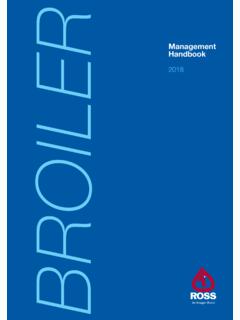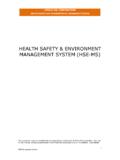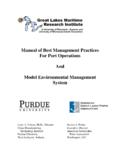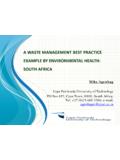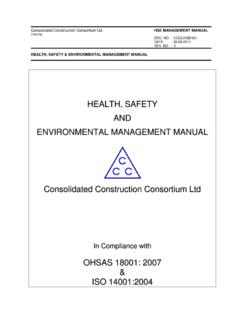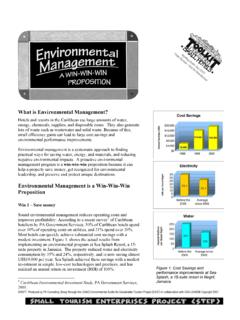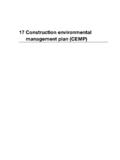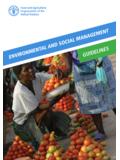Transcription of ROSS Environmental Management in the Broiler …
1 BROILERROSSE nvironmentalManagement in the Broiler House 2010 ross Environmental Management : Contents2 Contents03 Introduction: Economic Value of Proper Environmental Management03 Overview: Environmental Management Objective and Methods05 Economic Benefits of Environmental Control06 Climatic Factors in Housing and Ventilation Decisions06 Extremely Cold Climate07 Cold Climate07 Moderate Climate07 Hot Climate08 How Birds Work and What They Need 08 Birds Produce Heat and Moisture09 Effects of Temperature and Relative Humidity on Birds12 How Relative Humidity Works13 Ventilation Basics 13 Natural Ventilation14 Fan-Powered Ventilation15 Need for Tightly Sealed House15 Types of Negative-Pressure Ventilation Operations16 How Minimum Ventilation Works18 How Transitional Ventilation Works19 How Tunnel Ventilation Works20 How Evaporative Cooling Works22 Making Good Ventilation Decisions24 Choosing Fans26 Integrated Control System Decision Factors27 Air Inlet Design Considerations28 Benefits of Using Stir Fans29 Evaporative Cooling.
2 Foggers or Pads?29 Evaporative Pad Cooling: How Much Pad is Needed?30 Need for Backup and Fail-Safe Systems30 House Orientation31 Insulation Requirements32 Keys to Managing a Modern Tunnel House32 Which Ventilation Mode is Needed?33 Importance of Staying on Target Temperature34 Keys to Managing Minimum Ventilation36 Keys to Managing Transitional Ventilation36 Keys to Perimeter Inlet Management38 Keys to Managing Tunnel Ventilation40 Keys to Managing Tunnel and Evaporative Cooling41 Management Includes Monitoring43 Helpful Conversion FactorsAcknowledgment The main content of this publication was written by Professor James O. Donald, of Auburn University. Professor Donald is an agricultural engineer widely recognised as an authority on poultry housing and Environmental Management , and appreciation is expressed to him for permission to use these materials.
3 2010 Introduction: Economic Value of Proper Environmental ManagementWhether producing meat, eggs, milk or other animal products, it is well established that effectively managing Environmental conditions reduces the total cost of production. In the Broiler meat production business, all components of the production process from parent stock Broiler breeders to Broiler progeny benefit from effective Environmental control. Given the economic benefits of effective Environmental control it is imperative for managers and technicians to understand the basic concepts of this topic. This publication has a threefold purpose: To clarify what Environmental criteria and conditions are necessary to achieve the genetic potential of the modern Broiler . To outline the most important factors in the design of modern Broiler housing to be able to provide optimum Environmental conditions.
4 To provide basic operational guidelines for this housing. Key Point It is well established that effectively managing Environmental conditions reduces the cost of production. Overview: Environmental Management Objective and MethodsThe objective is to provide an environment to maximise flock performance, achieving optimum and uniform growth rate and feed efficiency in meat yield while ensuring that bird health and welfare are not compromised. Supplemental heating systems play an important role in Environmental Management , especially during the brooding phase. However, in many locations for a portion of the growout supplemental heating may not be needed. On the other hand, proper ventilation is needed throughout a growout, even during times when supplemental heat is being provided, for control of air quality if not for cooling. Ventilation is therefore the most important tool in managing the in-house environment for best bird performance.
5 Ways of providing supplemental heat in poultry houses around the world vary far more than do ventilation methods, relying on a wide variety of fuels and heat-delivery methods, including radiant and hot-air systems, direct in-house combustion and indirect heat-exchange, etc. Examination of the details of particular heating systems is beyond the scope of this publication, which focuses primarily on the most widely applicable principles of in-house Environmental Management . Except with very young birds and/or in very cold weather, temperature control is the primary goal of ventilation. At each stage of a bird s development, there will be a certain temperature zone in which a surplus of feed energy above the requirements of body maintenance allows the bird to gain weight, as shown in Figure 1. Within this broad thermal comfort zone there will be a narrow temperature range (within 1 or 2 C) in which the bird makes best use of feed energy for growth.
6 This is the optimum performance zone. Providing this optimum temperature - along with adequate feed and water - assures that the bird s welfare and economic performance are maximised. Note that, although there is a broader temperature range in which the birds will be more or less comfortable (the thermal comfort zone ), this publication, as is common in the industry, uses comfort zone to mean that narrower range of maximum comfort, the temperature that is the bull s-eye of the performance the temperature is too low, birds increase their feed intake but have to use more of that feed energy to keep their bodies warm. If temperature is too high, they reduce feed intake to limit heat production. Adequate ventilation prevents heat build up and keeps birds in their optimum performance zone, first by exhausting warm air from the house and replacing it with cooler outside air, and in most well equipped modern housing by effective (wind-chill) cooling through tunnel ventilation, and by lowering the actual air temperature through evaporative Environmental Management : Introduction32010 The target temperature for best Broiler performance changes during a growout, typically from around 30 C on day one to near 20 C or lower at harvest time, depending on bird size and other factors.
7 Ventilation therefore must be adjusted accordingly to maintain optimum temperature. The temperature experienced by the bird is dependant upon dry bulb temperature and humidity. If RH is outside the ideal range of 60-70%, the temperature of the house at bird level should be adjusted. For example, if RH is closer to 50%, the dry bulb temperature on day one may need to be increased to 33 C. At all stages, monitor bird behaviour to ensure that the bird is experiencing adequate temperatures. Ventilation is the only practical way to lower too high humidity, which is most often a winter problem and can affect bird health. Even when ventilation is not needed for heat removal, maintain at least a minimum rate of ventilation to prevent wet, caked litter and ammonia problems. By breathing, birds take oxygen out of the air and breathe out carbon dioxide, so fresh air must be brought into the house to replace that oxygen and exhaust the excess carbon dioxide.
8 Ventilation to provide fresh air is needed in all seasons and in hot and cold weather. The most common air quality problem, however, is ammonia coming from too wet litter, which leads to health problems and lowered performance. Proper ventilation heads off build up of ammonia by controlling relative of the above factors are important. Fortunately, in most situations bringing in fresh air and exhausting toxic fumes are accomplished by ventilation aimed primarily at controlling temperature and moisture. Important: proper in-house environment must be distributed evenly throughout the house. Pockets of dead air, drafts, cold spots, or hot spots can lower flock performance and even cause mortalities. Figure 1: Optimum performance temperature zoneAt each stage of a bird s development, there is one narrow temperature range where maintenance energy requirements are lowest and the bird can make maximum use of feed energy for growth.
9 If temperature goes just a few degrees outside the optimum performance zone, cooler or warmer, birds will be using a higher proportion of their feed energy for body maintenance and less for growth. Key Points Ventilation is the most important tool in managing the in-house environment for best bird performance. At each stage of a bird s development, there is one optimum performance temperature zone in which the bird makes best use of feed energy for growth. The target temperature for best Broiler performance changes daily during a growout, ventilation must be adjusted accordingly. In-house environment must be uniform: pockets of dead air, drafts, cold spots or hot spots can lower flock performance. Increasing Cold StressColdCoolerWarmerHotTemperatureIncr easing Heat StressThermal Comfort ZoneTotal Metabolisable Energy Maintenance Energy RequirementsAmount of Energy DeficitAmount of Energy Surplus Available for Growth and Weight GainAmount of Energy DeficitOptimum Performance ZoneROSS Environmental Management : Introduction42010 Economic Benefits of Environmental ControlBirds most efficiently convert feed to meat when they are given consistently optimum Environmental conditions, with temperature being the most critical factor.
10 Small temperature differences can have a significant effect on returns to the owner. This has been well confirmed by research and by experience worldwide. Figure 2 below shows differences in total cents per bird value resulting from on-target vs. off-target temperatures, based on a computer study of temperature effects on bird performance. The study is based on, and figures given solely for, the growing stage after brooding, when the target temperature has levelled off at about 22 C. Under these conditions, consistently missing target temperature on the high side by only C would mean a one cent loss in value per bird. During the brooding phase, even brief chilling can seriously hurt flock performance. For example, university research in the United States showed that exposing day-old chicks to an air temperature of 13 C for only 45 minutes reduced 35 day weights by about 110 grammes.






